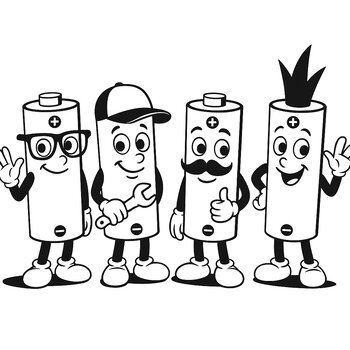- Tips
- technology
- Frequently Asked Questions
- Tests
- mAh capacity
- Rated Capacity
- comparison
- everActive
- Batteries vs rechargeable batteries
- Durability of rechargeable batteries
- Efficiency of rechargeable batteries
- battery voltage
- Accumulated energy
- LR03 AAA
- LR6 AA
- eneloop
- AG13 LR1154 LR44
- CR 2032
- Delta V
- Charge Cycles
- internal resistance
- charge level
- memory effect
- accredited test
- SR44 357
- Hearing Batteries 675
- SR626 377
- Watch Batteries
- Polarity
- Mah
- passivation
- LS 14250
- LS 14500
Unusual types of AA batteries and accumulators

AA batteries and accumulators, due to their size, are very popular, commonly used sources of energy used in everyday devices. However, you can find not only basic alkaline cells or NiMH batteries on sale. In this article, we will describe less common variants that have specific properties and are dedicated to slightly more specialized or demanding applications.
AA Lithium Batteries for Special Applications
Some AA lithium batteries have improved performance that reduces their internal resistance. Their cells can deliver very high currents, making them ideal for devices with high power requirements. Lithium AA batteries are also often characterized by a long life - it maintains up to 90% capacity during a storage period of 10 years. Due to the very wide operating temperature range, there are no contraindications to their use in outdoor conditions. This issue is particularly important when powering cameras or flashlights. Lithium batteries provide optimal performance for devices with high power consumption, but in combination, e.g. with alkaline cells, they are characterized by a higher price.
AA rechargeable batteries with USB charging function
Quite unusual AA batteries include models made in lithium-ion technology with an integrated USB port, which allows the cell to be charged directly without using an external charger. This solution is particularly appreciated for its mobility and comfort. AA rechargeable batteries with USB function usually have a stable and high output voltage, which ensures compatibility with most devices optimized for use with disposable batteries. They successfully power Christmas lights, photo traps, flashes, radios or photographic equipment. The disadvantages of such batteries often include the ability to charge only via USB or a dedicated charger. Products of this type often have colored LEDs that indicate the charging status.
Alkaline batteries with improved performance
Currently, you can also find alkaline batteries on sale, which are characterized by increased performance in devices with increased power consumption. Their operating time is longer by up to several dozen percent, which is especially important in the case of equipment with high energy demand. R6 batteries of this type are typically subjected to multiple performance tests, which are based on measuring capacity from discharge. The benefits of such products often include other improvements, including a reinforced and sealed structure. An AAA or AA battery thus gains high resistance to pouring, maintaining its usability for a very long shelf life. The possibility of using it with devices with both low and high power consumption is also important. They are successfully used, for example, with remote controls, clocks, digital cameras or even medical equipment.
Stable and safe lithium iron phosphate cells
Unusual solutions in the size of standard AA batteries and accumulators include lithium iron phosphate (LiFePO₄) cells, which are characterized by a nominal voltage of 3.2 V. Their parameters are therefore too demanding for devices with a standard demand of 1.5 V. However, these types of cells are characterized by very high chemical and thermal stability, which makes them an optimal solution for specialized applications. They successfully prove themselves in terms of high resistance to extreme weather conditions, as well as high charging cycling. As a rule, their capacity is between 400 and 600 mAh. AA-sized lithium iron phosphate cells have a very long service life, as they can withstand up to 9000 charging cycles. Their advantage is also low toxicity, associated with the lack of cobalt use. However, it is worth remembering that the increased nominal voltage significantly reduces compatibility with many popular devices.